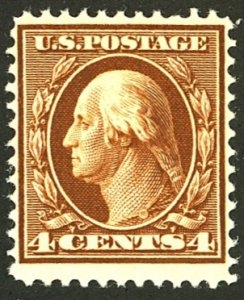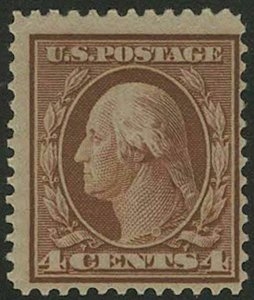Item misrepresented?

The first image is a stamp that is about to be auctioned off in about two hours. It is described as US #360, which is one of the rare bluish paper Washington & Franklin stamps. There are only about 78 known copies of the stamp and it catalogs for over $27,000 dollars. The current high bid for the stamp is $338.33. The scan, however, does not look in the slightest like bluish paper. Here is an authentic US #360 available from a different Hipstamp dealer:
 #360 Malack" title="US #360 Malack" />
#360 Malack" title="US #360 Malack" />It is being offered for $25,850, which is about what one would expect for this stamp.
The stamp being auctioned off is likely #334. There are several mint #334's available on Hipstamp, one for less than $10 and, on the high end, a couple over $100, depending of condition.
I wrote to the seller seven hours ago questioning the accuracy of the listing, but got no response nor any change in the listing. I reported the item to the Hipstamp Admin, though less than an hour ago, so it is not surprising that they have not yet responded.
I understand the so called "let the buyer beware" view of philatelic transactions, but I dislike seeing stamps misrepresented -- assuming that I am correct in my assessment. Whoever wins this item is either going to have gotten the bargain of the year (a few hundred dollars for a stamp worth over $25K) or will have vastly overpaid for what should be a roughly $40 stamp. There should be a way to get listing like this corrected before the auction comes to a close.

Comments
denomination of stamps did not match up with Scott catalog numbers. And then it becomes very difficult to rely on the accuracy of any listings especially with no response from the seller?
Just another example of why it is so important to do business with quality, ethical dealers and maybe, possibly even more important for customers to be educated as to be aware of any "red flags" that may be present in an offering...especially in an online marketplace.
Your commentary exemplifies and amplifies the importance of both the challenge of the online marketplace for philatelic material and the value of doing business with trusted and quality online dealers. It also points out the challenges of the dealers' efforts to provide quality images of items listed. Everything from poorly taken, out of focus, obliquely taken cell phone photos to high quality, professional scans. Shade varieties, catalog descriptions notwithstanding, can, as you well know, be quite subtle and online listings should rely on the experience and quality of descriptions by a given dealer, and in fact, many should have some expertization if there is any significant value difference between shades. Having said that, I'll go back to my original point, and a shameless plug for the efforts of the IPDA, it is critical for both the dealers and customers to, in an online marketplace, to have as much quality information as possible. This provides for the possibility of many satisfactory transactions and reduces the chances of disappointment. Lots of words but I hope you get my drift. (I think I may have used too many commas...but that's just me eh!).
That is because a number of dealers on here do not know what they are offering because they:
1: Do not care.
2: Have people listing the item do not know anything about what they are listing.
3: Sell the item hoping it will stick because they thing\k that most people are stupid.
Leaving a neutral response keep these people still listing and does not help at all. The problem is that when you send a high priced item out to get certified (like your example) it takes more then 45 days and you can not leave a negative. The stamp clearly was not a # 360 and it was also re-perforated on the right side which was clear in the photo.
I am going to say it now the seller of this stamp is the the company who owns this web site. By doing this the quality of this site goes down and it does no good for anyone else who sells on here.
I used to sell on eBay and did so for over 20 years. I quit because of managed payments and the way I have been in the business for over 45 years. I have been a member of APS for almost 30 years and if I sold something like this I would have been kicked out.
This is totally unacceptable and like Greg said he has bought stamps from this seller and had to return a number of them which the seller made good immediately which is fine an dandy but how many more did not know what they were buying. Through the years I have run across many people who bought something and then later found out that what they bought was garbage.
It is a shame but it happens all the time. As the old axiom goes buyer beware.
Sorry it was John E. and it is Friday night. LoL
Simple contrast example will demonstrate the probability of the stamp being a bluish paper. Simply compare your "bluish paper" example to any known non-bluish paper FW stamp, by placing them face down on an ORANGE background. This creates a good contrast for this issue. Then compare the two, as in this example:
Where the bluish example is on the left.
If you find a seller offering such a bluish paper stamp, ask them to post a contrast image such as this for proof of it's bluish content.
It is even better if they have one of same denomination (i.e. in this example, compare a 360 candidate with a 334, both perf 12, both 4c, both on double watermark paper, makes for a great comparison).
And therein lay another point, ask them to watermark it. If it's not double-line, it's not bluish paper.
an idiot." Someone with $960 to spend on a stamp sight unseen should just know
better. Is critical thinking dead in this era?
Consider:
1. To say there are 78 known examples is to say there are 78 certificates. Does this stamp have a certificate?
2. To offer such a rarity with no fanfare is nonsensical. Did we read about this new discovery in Linn's? To offer it in an auction on hipstamp is just ludicrous.
3. Everything about US 360 depends on the paper, yet the dealer did not offer a scan of the back of the stamp.
4. And finally, did the buyer believe the dealer had offered the stamp by accident? Perhaps. Do dealers make such accidents? My fat white kazakis. Any dealer who would make such a mistake, or let the staff make such a mistake, would not have had an example of US 360.
Blame certainly rests with the dealer in this matter, but I'm not going to feel sorry for someone willing and able to drop a grand on a stamp without due and proper diligence. I know that's not the point, and I know he can get his money back. It's a shame that this dealer thinks so little of the stamp buying public, but we've been here before and the real shame is that each time he does it, he finds a sucker ready to oblige him.
I might have mentioned this earlier, but this exact auction scenario occurred before for stamps that had a much higher catalog value than the 360 in question.
But any coils should be looked upon with great suspicion especial if their CV for used is greater than MNH.
And then, single line watermarks v no watermark is another common oversight.
Just take your time.
Not even a catalog number. Just a vague reference to the stamp being rare and vintage when, in fact, it's a run-of-the-mill near-worthless item. Grifting is disgusting and no less so if the victim happens to be a fool or senile or old or needy.